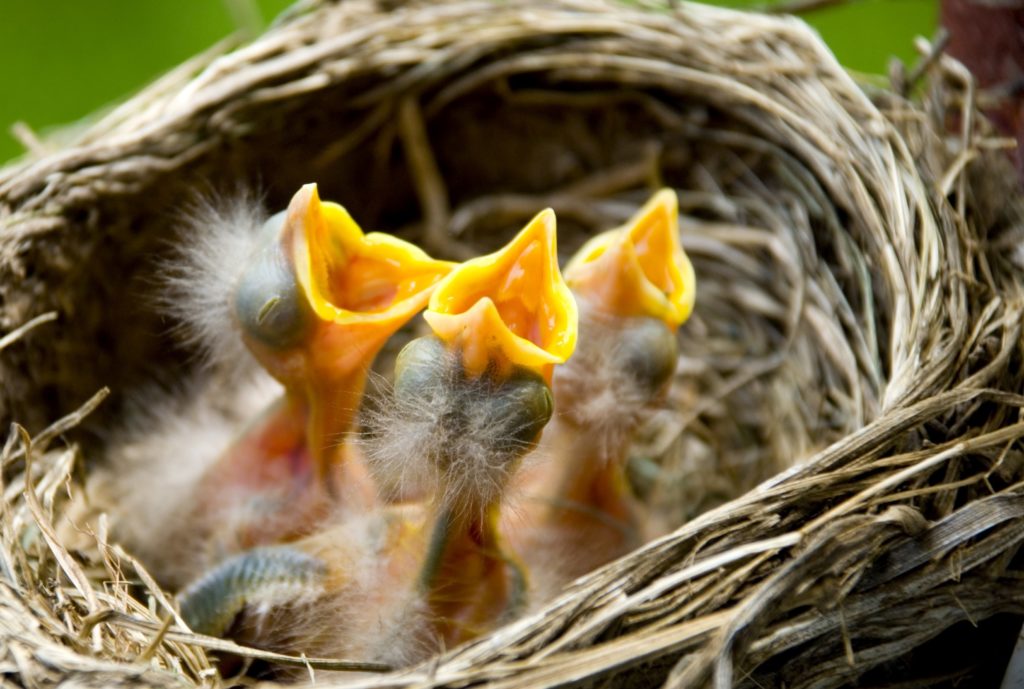It seems that spring has finally come to Southern Wisconsin. The snow has melted. Most days it is warm enough you can go outside without a parka, hat and mittens. The tree buds are starting to swell. And that traditional oracle of spring, the American robin (Turdus migratorius), has been spotted in trees and yards—along with its less friendly cousin, the red winged black bird (Agelaius phoeniceus).

While spring brings the return of migratory birds, it also brings an increase in the number of rescued baby birds flooding into local wildlife rescues and humane societies. When the babies come to these centers, they need a warm, soft, breathable and washable home that resembles the nest they were hatched in.
It turns out that knitted or crocheted nests are a perfect solution. The nests aren’t just used for baby birds; baby rabbits, squirrels, bats, ferrets and racoons are just a few additional animals that benefit. And the best part is, you could be improving your own health while you create those cozy nests.
Knitting can help you relax and manage pain
There is a relatively large body of research that shows knitting, along with crafts such as crocheting and needlework, offer a number of health benefits. Some knitters liken the repeated rhythmic movements of knitting to meditation, with the added benefit of a tactile product to show when you are done. The repetitive nature of knitting can help lower blood pressure and induce what is known as the relaxation response (1,2). The chemical characteristics of the relaxation response could also buffer areas in the brain from the “neurotoxic” effects of stress that could have long-term cognitive ramifications.
Studies have also found the knitting can be an effective tool to help manage chronic pain (3). By lowering stress levels, facilitating relaxation and helping disrupt the way the brain responds to chronic pain, knitting offers a way to for individuals to take ownership of their situation and environment. It also offers a path for increased social interaction and a way to reclaim a positive identity (4).
Knitting keeps your mind active, which may help delay or minimize mental decline due to age and dementia
Participating in activities such as knitting or quilting has been correlated to a decrease in the odds of experiencing age-related mild cognitive impairment (MCI; 5) and could reduce the risk of Alzheimer’s disease or dementia (6). MCI is the intermediate stage between normal age-related cognitive changes and dementia. A study of over 1,300 individuals over the age of 70 found that activities including using the computer, reading, playing games and crafts such as knitting were associated with a 30-50% reduction in the odds of having MCI (5).
Knitting was one of thirteen leisure activities used in a study of over 1,700 individuals over 65 that showed participation in leisure activities was associated with a reduce risk of dementia and Alzheimer’s disease (6). The higher the level of engagement in the activities, the lower the risk of developing dementia, with the highest level of engagement corresponding to a 38% less risk of developing dementia.
These studies did not address the mechanism of action for the results. Involvement in cognitive and social activities could act to strengthen or even help generate neural networks in the brain, and these networks could act as a buffer for dementia (5,6).
Are you ready to pick up some yarn and get involved?
If you knit or crochet and want to help create nests for baby birds, check with local organizations to see if they have a use for nests (no one wants to create something that won’t be used). If your rescue doesn’t have a pattern, you can search online. There are numerous wildlife rescue nest patterns, but there are some things that are universal.
- The nests need to be tightly knitted or crocheted (think about holding two strands of yarn together). They should be able to stand on their own (no slouching).
- The nests should be made from smooth, machine washable yarn. The nests are washed often, so they need to be made to withstand multiple washings.
- The nest can be any color (or multiple colors) and can range in size from tiny to large (approximately the size of an adult hat), so get ready to clear out some odds and ends from your yarn stash!
If you don’t know how to knit or crochet and you want to learn, check for beginner’s classes at your local craft or yarn stores. Can’t find a class? Ask around. You might be surprised how many of your friends, family or coworkers know how to knit and are happy to teach you the basics. There are also a wide range of tutorials available online. Finally, don’t get discouraged. Learning a new skill takes time, but there are all sorts of the reasons why it is worth the effort.
References
- Benson, H (1975) The Relaxation Response. New York. Harper Torch.
- Schaffer, S. and C.B. Yucha (2004) The American Journal of Nursing 104, 75–82.
- McFarlane, A. (2007) Best Practice Research Clinical Rhematology 21, 549–65.
- Reynold, F. (2003) OTJR: Occupation, Participation and Health 23, 118–27.
- Geda, Y.E. et al. (2011) J. Neuropsychiatry clin. Neurosci. 23, 149–54.
- Scarmeas, N et al. (2001) Neurology 57, 2236–42.
